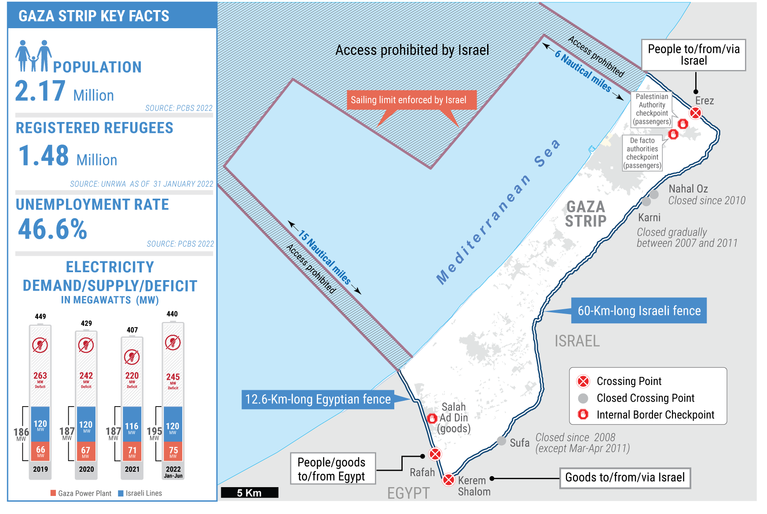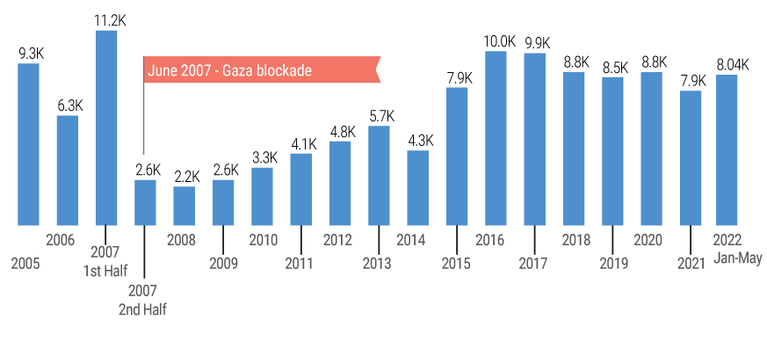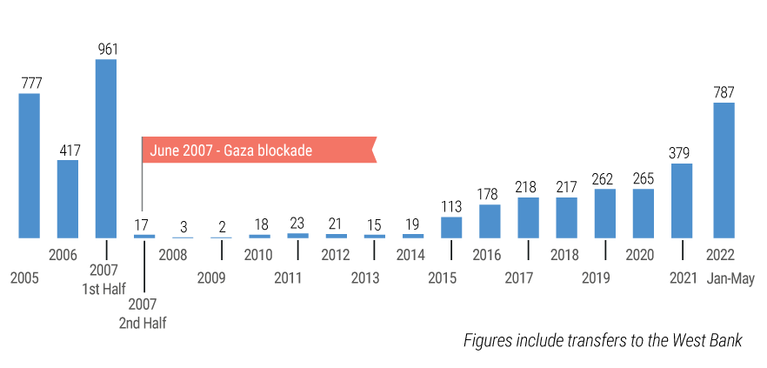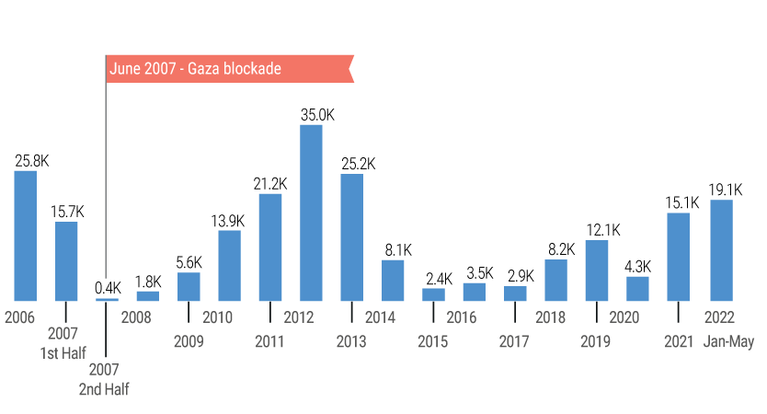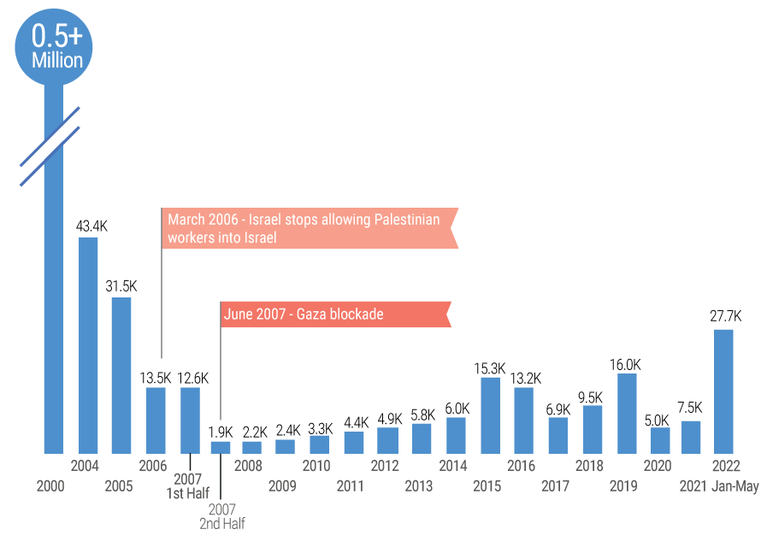Gaza Strip | The humanitarian impact of 15 years of the blockade - June 2022
Key facts
- In June 2007, following the military takeover of Gaza by Hamas, the Israeli authorities significantly intensified existing movement restrictions, virtually isolating the Gaza Strip from the rest of the occupied Palestinian territory (OPT), and the world. This land, sea and air blockade has significantly exacerbated previous restrictions, limiting the number and specified categories of people and goods allowed in and out through the Israeli-controlled crossings.
- Prior to the Second Intifada in 2000, up to half a million exits of people from Gaza into Israel, primarily workers, were recorded in a single month. For the first seven years of the blockade, this number declined to just over 4,000 on average, rising to 10,400 monthly over the next eight years.
- So far in 2022, the Israeli authorities have approved only 64% of patients’ requests to exit Gaza mainly for specialized treatment in the West Bank, including East Jerusalem, by the time of the scheduled medical appointment. In previous years, patients have died while awaiting a response to their application.
- The Egyptian authorities closed the Rafah border crossing with Gaza for long periods after 2014 following political unrest in Egypt. Rafah has been mostly operational since mid-2018, and was open for 95 days out of 151 in the first five months of 2022.
- After the blockade, the number of truckloads of commercial goods exiting Gaza dropped significantly to only two truckloads on average per month in 2009. Following the 2014 escalation of hostilities, commercial transfers from Gaza to the West Bank resumed, and from March 2015 exports to Israel also resumed. In August 2021, exports to Egypt started for the first time, boosting the monthly average of exports to 787 in the first five months of 2022. Pre-blockade, the average monthly high was 961.
- The volume of truckloads entering Gaza in the first five months of 2022, around 8,000 per month, was about 30% below the monthly average for the first half of 2007, before the blockade. Since then, the population has grown by more than 50%.
- Israeli forces have largely restricted access to areas within 300 metres of the Gaza side of the perimeter fence with Israel; areas several hundred metres beyond are deemed not safe, preventing, or discouraging, agricultural activities.
- Israeli forces restrict access off the Gaza coast, currently only allowing fishermen to access 50% of the fishing waters allocated for this purpose under the Oslo Accords.
- Unemployment levels in Gaza are amongst the highest in the world: the Q1 jobless rate in 2022 was 46.6%, compared with an average of 34.8% in 2006. Youth unemployment for the same period (age 15-29) stands at 62.5%. (PCBS)
- 31% of households in Gaza have difficulties meeting essential education needs such as tuition fees and books, due to lack of financial resources.
- 1.3 million out of 2.1 million Palestinians in Gaza (62%) require food assistance.
- At its current operating capacity, the Gaza Power Plant can only produce up to 80 megawatts (MW), supplemented by 120 MW purchased from Israel, meeting about 50% of the electricity demand in Gaza (400-450MW). In 2021, rolling power cuts averaged 11 hours per day.
- 78% of piped water in Gaza is unfit for human consumption.
- About 2.1 million Palestinians in Gaza are ‘locked in’, the vast majority unable to access the remainder of the OPT and the outside world, limiting access to medical treatment unavailable in Gaza, to higher education, to family and social life, and to employment and economic opportunities. Movement restrictions imposed by the Israeli authorities since the early 1990s and which were intensified after the Hamas takeover of June 2007, citing security justifications, have had a profound impact on living conditions in Gaza and have fragmented the territorial unity and the economic and social fabric of the OPT. Those eligible for exit permits constitute a small minority, primarily day labourers, businesspeople, medical patients and staff of international organizations. While the isolation of Gaza has been eased to some degree by Egypt’s reopening of the Rafah crossing since 2018, movement through Rafah remains restricted and the selection criteria for travelers uncertain.
- Longstanding access restrictions imposed by the Israeli authorities have undermined Gaza’s economy, resulting in high unemployment, food insecurity and aid dependency. These include restrictions on the marketing of goods in the West Bank and Israel; on the entry of certain goods to Gaza; and on the access of people to agricultural land and fishing waters in Gaza itself. The impact of access restrictions is compounded by recurrent rounds of hostilities, which have resulted in the loss of assets and people being left with long-term disabilities; by a chronic energy crisis; and by the ongoing internal Palestinian divide. In August 2021, the Israeli authorities expanded the number of items permitted into Gaza, lifting broad restrictions introduced during the May 2021 escalation.
- Restrictions on the entry of goods considered by the Israeli authorities as ’dual-use’ items, imposed citing security concerns, continue to undermine the quality of basic services and impede efforts to address housing needs. Limited access to construction materials and critical equipment since 2007 has delayed the construction, repair and upgrade of homes and infrastructure needed to address high population growth and the devastation caused by recurrent hostilities. This has undermined the quality of health, education, and water and sanitation services available in Gaza, and prolonged the displacement of those who have lost their homes. Although, following the 2014 hostilities, the entry of restricted construction materials has been facilitated by the temporary Gaza Reconstruction Mechanism (GRM), the entry of other restricted items, particularly those required for water and sanitation projects, remains a major challenge.
- The blockade has raised concern about collective punishment and other possible violations under international humanitarian and human rights law. The blockade on Gaza should be fully lifted in line with Security Council Resolution 1860. However, improvements can still be made within the framework of the blockade regarding easing the restrictions on the entry and exit of people and goods.
